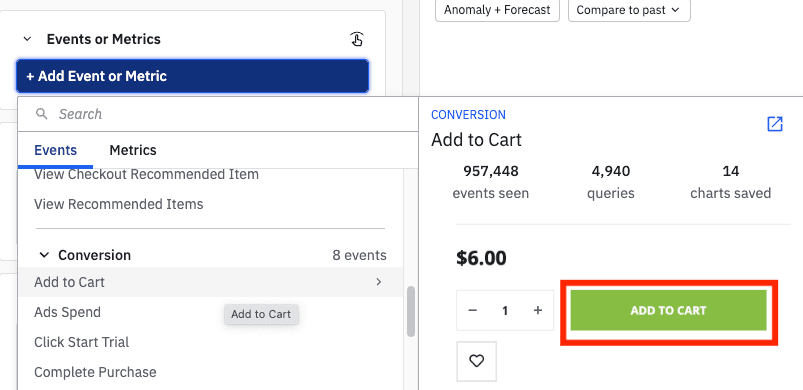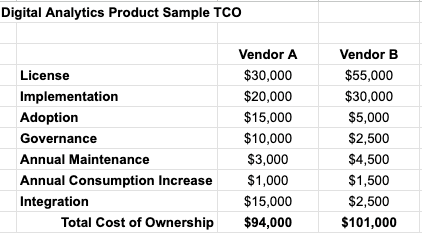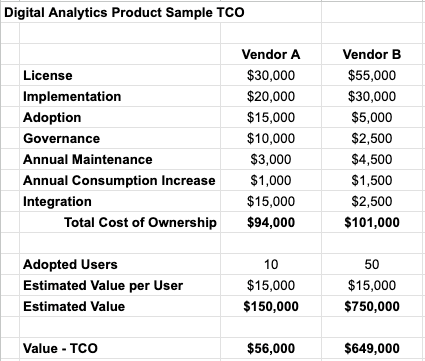Digital Analytics Total Cost of Ownership
Are you factoring all ownership costs into your digital analytics purchasing decsions?
A few weeks ago, I wrote a blog post positing that many organizations use the wrong criteria when selecting digital analytics products. One of the items I mentioned in this post was that the price of digital analytics products is too often overweighted in product selection. In this post, I’d like to dig deeper into this topic and discuss the total cost of ownership of digital analytics.
Total Cost of Ownership
The total cost of ownership for digital analytics products is typically comprised of the following components:
- License – How much do you pay a vendor for software?
- Implementation – How many resources and time does it take to implement?
- Adoption – How easy is the tool to adopt, and how many users use it?
- Governance – How easy is managing data quality, users, and analytics objects?
- Maintenance – How difficult is maintaining the product once implemented?
- Consumption – How expensive is the product as usage or data volumes increase?
- Integration – How easy is integrating the product within your broader tech stack?
These elements have related costs or potential cost savings that add up to the total cost of ownership. Let’s go through all of these individually.
License
As mentioned above, organizations excessively emphasize license prices when choosing digital analytics products. Organizations focus on license costs so much because it is a hard cost – something you can see and easily measure. It is easy to compare vendor A to vendor B when vendor A charges €250,000 and vendor B charges €175,000 annually. But as I will demonstrate below, the amount spent on a digital analytics program should be much more considerable than the licensing cost. It isn’t free even if you use a free version of a digital analytics product. There are always costs associated with a digital analytics program.
Implementation
The initial implementation can be done cheaply or more expensively. The cost is dependent on how you approach the implementation. Everyone has heard the adage that digital analytics is easy – paste a few lines of code on your website, and start getting data! Vendors are notorious for selling this narrative, especially vendors that offer “auto-track” solutions.
But if you want to implement digital analytics properly, it is a complex multi-step process that involves identifying business objectives, use cases, business questions, data elements, etc. The best digital analytics implementations take the time to determine what they hope to accomplish and only then start the tagging process. The digital analytics implementations I have seen fail are the ones that begin with tagging and then try to identify uses for the data after the fact.
Therefore, if you want to maximize your chances of success in digital analytics, I suggest you implement (or, nowadays, re-implement) the correct way. Implementing digital analytics correctly will require a lot of time up-front to identify business objectives and use cases, which involves a lot of internal stakeholder meetings and the help of external or vendor consultants. The time spent on internal meetings is critical, but assigning a cost to these meetings is challenging. Soft costs are much of the work needed to prepare for a successful digital analytics implementation. I am shocked at how many organizations assume these costs are “free” because they don’t have to cut a check for the time spent unless it is for outside consultants. But the time spent with internal resources still costs the organization money via salaries and the opportunity costs of what employees could be working on instead of focusing on digital analytics. In a perfect world, organizations would keep track of all time internal employees spend on the digital analytics implementation and factor that into the overall cost. You should add this amount to any spent on consultants assisting with the implementation. Depending on the size and scope of the implementation, these amounts could exceed the amount spent on vendor licensing costs!
Adoption
In the digital analytics industry, adoption is a secret many organizations don’t like discussing. When organizations pitch the idea of implementing digital analytics, it is under the mantra that everyone can access data and make more informed data-driven decisions! Over the years, I have done a lot of consulting in the digital analytics space. One of my consulting services was auditing digital analytics implementations. I learned two big things. First, there are a lot of terrible digital analytics implementations out there! Second, in many organizations, only a few people actively use digital analytics weekly.
The adoption of digital analytics is problematic for several reasons. To begin with, many people like to say they believe in data and want to leverage data in decision-making, but they are disingenuous. Managers and executives often get to where they are by trusting their gut instincts. If they base decisions on data, then why are they needed? Why couldn’t the organization replace them with less expensive resources that follow the data? Change management is a massive portion of adoption. Before you can get leadership to review and make decisions based on data, you need to convince them that data is their friend, not their enemy.
If you can overcome that hurdle, the next step is to educate stakeholders and data consumers about what data exists in your digital analytics implementation. While the core analytics team may understand all the events and properties in the implementation, most casual data users will not. Getting as many potential data consumers as possible is essential to understand what data you do and do not have in the implementation. They need to know the names of each event and property, when they are set, etc. (This is one of the reasons why Amplitude includes the ability to share a screenshot of where events are set which users can see when they are browsing events).

After educating users on why data is good and what data you have, the next step is to teach them how to use your digital analytics product. In this regard, not all digital analytics products are created equal. Some digital analytics products are easier than others for getting many users to perform self-service analytics. The complexity of the analytics reporting interface can significantly impact training and adoption. Suppose many data consumers cannot easily learn the digital analytics reporting interface within the organization. In that case, it will force you to move from a self-service to a centralized model. In a centralized model, data consumers request assistance from a centralized team for reports and dashboards instead of data consumers creating reports themselves. A centralized model for digital analytics isn’t inherently wrong, especially in large organizations. But I have seen many organizations think they were investing in a self-service digital analytics program only to find out later that it had morphed into a centralized model. In most cases, the reason self-service didn’t work was related to adoption.
Regarding the total cost of ownership, there is always a cost associated with driving the adoption of digital analytics. You will need to spend time on change management with employees and often with employees who are higher on the pay scales! Additionally, you will have to spend time training employees on what is in your analytics implementation and how to use the analytics product. If you pay an outside vendor or consultant for this training, you may have a hard cost to measure this, but if you conduct training internally, it will be another soft cost for you to try and compute. You should include all of these costs in your total cost of ownership calculations.
However, one of the reasons that we implement digital analytics in the first place is to generate a return on investment. The idea is that digital analytics data will unlock insights and learnings that will help the organization make more money. For example, if you were a retailer, digital analytics may show that users add a lot of money to the shopping cart. Still, only a tiny portion turns into revenue. Digital analytics data can help you identify which products and product categories are most impacted and help identify hypotheses as to why so much revenue is lost. If you identify potential solutions, digital analytics can show you if your hypotheses were right or wrong and prove that you have made the company more money!
However, return on investment is often linked to adoption. The fewer people you have leveraging digital analytics data, the fewer “Aha” moments you may come up with that enable you to save or make more money. Hence, if you fail to get many people within the organization to adopt your digital analytics implementation, you may incur all of the costs, your cost per employee may go up, and you may not realize the benefits. For example, if your adoption costs (internal employee time + outside resources) are €150,000 and you only have five people actively using the digital analytics implementation, that can look expensive (€30,000 per employee) vs. if you have one-hundred-fifty active users (€1,000 per employee). Plus, you only have five active users; it may be more challenging to identify revenue generation or savings opportunities than if you have many more.
Governance
Digital analytics implementations require effective governance to be successful. Digital analytics data governance includes the following:
- Maintaining an up-to-date implementation data dictionary
- Validating that all data collected is part of the schema
- Identifying which analytics objects are “official” and correct
- Reducing or eliminating the duplication of analytics implementation objects
- Monitoring which analytics reports, dashboards, and objects are used and not used
- Fixing or removing bad data added to the analytics implementation
- Testing that analytics tagging is always up and running
- Verifying data privacy compliance
- Acting upon data privacy deletion requests
As you can see, data governance requires significant work. If you want to learn more about why each of these steps is important, you can read my recent blog post on the significance of data governance.
Once again, many of these activities are soft costs, but it can take enormous time to address all of these data governance items. In addition, some digital analytics products make data governance easier or more difficult. In some cases, the hard cost of a digital analytics vendor’s license may be more, but the soft cost of attending to data governance is lower. Conversely, some digital analytics products appear inexpensive but become more expensive when factoring in manual data governance time. One way or another, you should find a way to compute all these costs when determining the total cost of ownership.
Maintenance
After implementing a digital analytics product, there will always be ongoing maintenance. Your digital analytics implementation should not be static. It should evolve with the organization such that you add new use cases and business questions as the organization grows. In general, there is a direct correlation between implementation costs and maintenance costs. Digital analytics products that are expensive and time-consuming to implement are also expensive and time-consuming to maintain.
In many respects, the maintenance of a digital analytics product is a microcosm of all of the preceding items. When maintaining a digital analytics product you have to implement new items, get users to adopt them, and provide additional training. The difficulty or ease of completing these steps during the initial implementation foreshadows the time and money that will be needed for ongoing maintenance. Therefore, I suggest you estimate the maintenance cost to be 10% -15 % of the initial implementation cost annually.
Consumption
When you purchase a digital analytics product, there are typically two pricing options – pay for events or monthly tracked users. For most organizations, the number of events and MTUs rises each year. These pricing models mean you pay more for your digital analytics product each year. Depending on the vendor, increased volumes can bring your overall rate down, so increased consumption may not have a 1:1 impact on price. But monitoring consumption is something analytics teams should do to make sure they plan for and budget for potential increases.
Amplitude helps its customers identify cases where customers are collecting a lot of events, but those events aren’t used often. While it sounds counter-intuitive, Amplitude is going out of its way to show customers where they can pay us less money! We do this because we want to drive customer value and believe in the total cost of ownership. We don’t want customers collecting data they are not actively using.
Integration
The last area of cost of ownership is integration. Digital analytics implementations don’t exist in a vacuum. Data from other systems must be added to digital analytics implementations, and data from digital analytics is often sent to other systems. For example, suppose your digital analytics implementation has profiles for known users. In that case, there may be data from a data warehouse or CRM system that you want to send into the digital analytics system to enrich user profiles. In addition, there may be cases in which a data user identifies a cohort of users that have abandoned products in their shopping cart and wants to send those users to an email tool so they can receive an email reminding them they left products in the cart.
Whether data is going in or out of digital analytics, work is required to connect data sources. When calculating the total cost of ownership, it is essential to identify how many data integrations will be needed so you allocate time and budget accordingly. Failure to do this can lead to unexpected costs after implementing the digital analytics product. As was the case before, some digital analytics products may make integrating data between systems easier or more challenging. This information is critical to understand before selecting a digital analytics product. I have seen many organizations skip this step and later regret that they initially went with a cheaper analytics product and then had to expend significant resources on data integration.
TCO Example
Let’s compare two different digital analytics products with a sample TCO analysis. Suppose you were comparing two different vendors where one was significantly more expensive than the other, but had lower costs when it came to items outside the licensing cost as shown here:

In this scenario, the initial licensing cost of Vendor B is almost double that of Vendor A. But the costs of adoption, governance, and integration are higher. When factoring in all of the costs, Vendor B is still more expensive than Vendor A, but the difference in cost of ownership is only about 7% more overall.
Next, let’s suppose that an organization implementing Vendor B can get 50 fully adopted users, but an organization implementing Vendor A can only get 10. If we pick a baseline amount of value that we believe can be derived from the use of digital analytics in a year (can be incremental revenue or cost savings), we can do a ballpark estimate of expected value:

If we combine the costs and the value and look at the entire scenario, it may turn out that in the long run, the total cost of ownership between Vendor A and Vendor B isn’t very significant. This is especially true if you factor in the potential incremental value you can achieve if Vendor B’s product can be more easily adopted and adoption can be turned into value.

Summary
As you can see, there is much more to calculating the total cost of ownership than licensing costs. When your organization is evaluating digital analytics vendors, I recommend calculating the total cost of ownership using all of the implementation costs. I also recommend factoring into the equation the revenue or cost savings opportunities each product provides.

Adam Greco
Former Product Evangelist, Amplitude
Adam Greco is one of the leading voices in the digital analytics industry. Over the past 20 years, Adam has advised hundreds of organizations on analytics best practices and has authored over 300 blogs and one book related to analytics. Adam is a frequent speaker at analytics conferences and has served on the board of the Digital Analytics Association.
More from Adam





